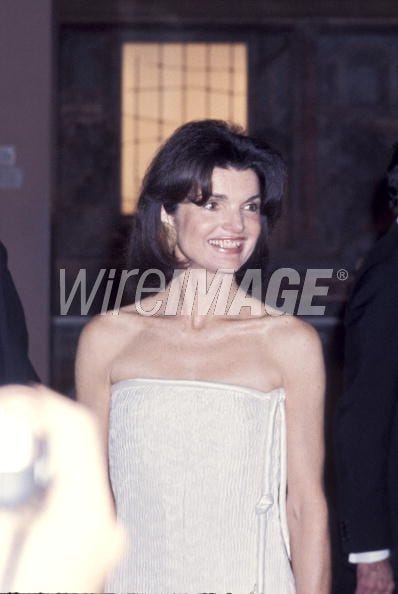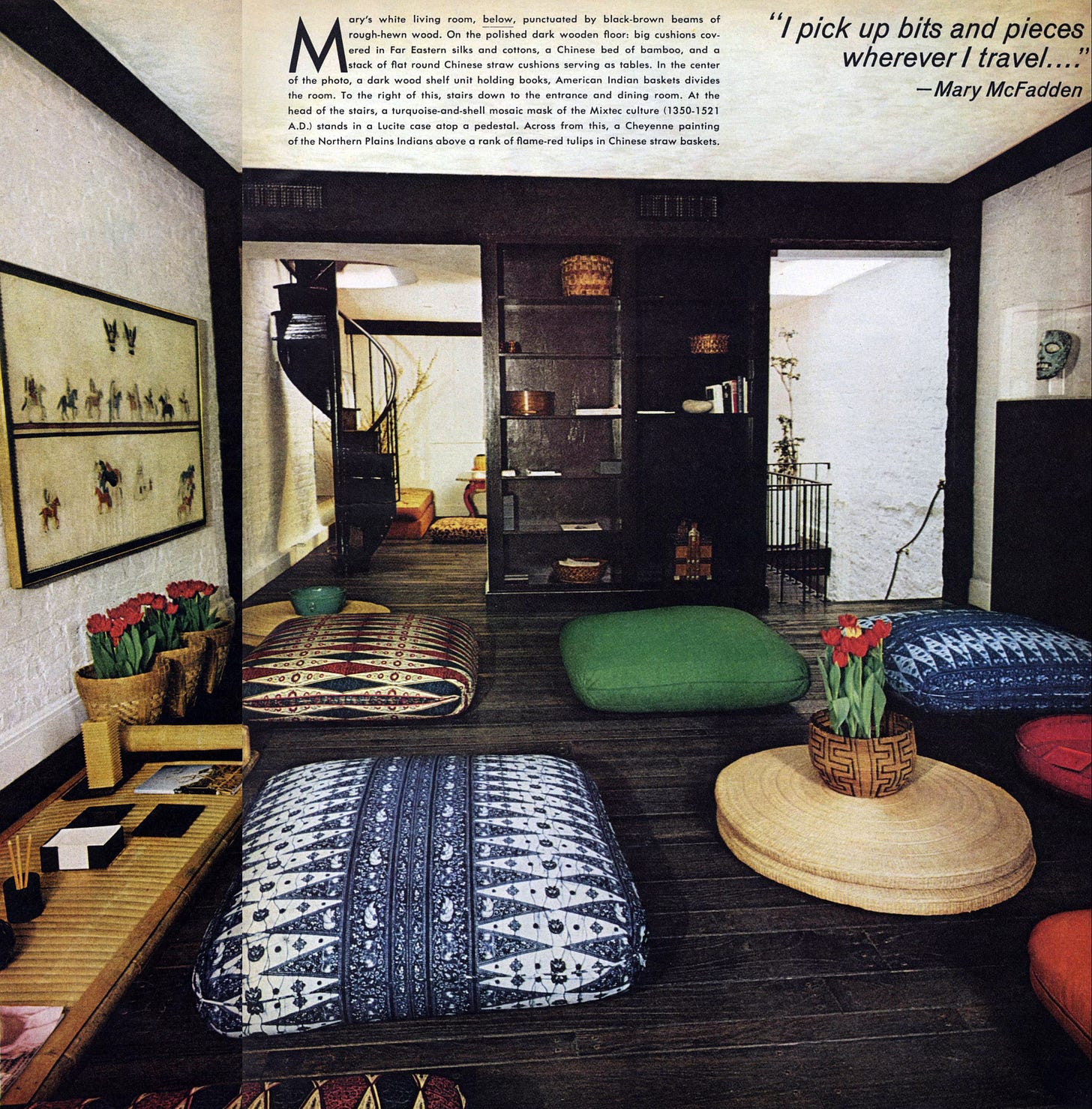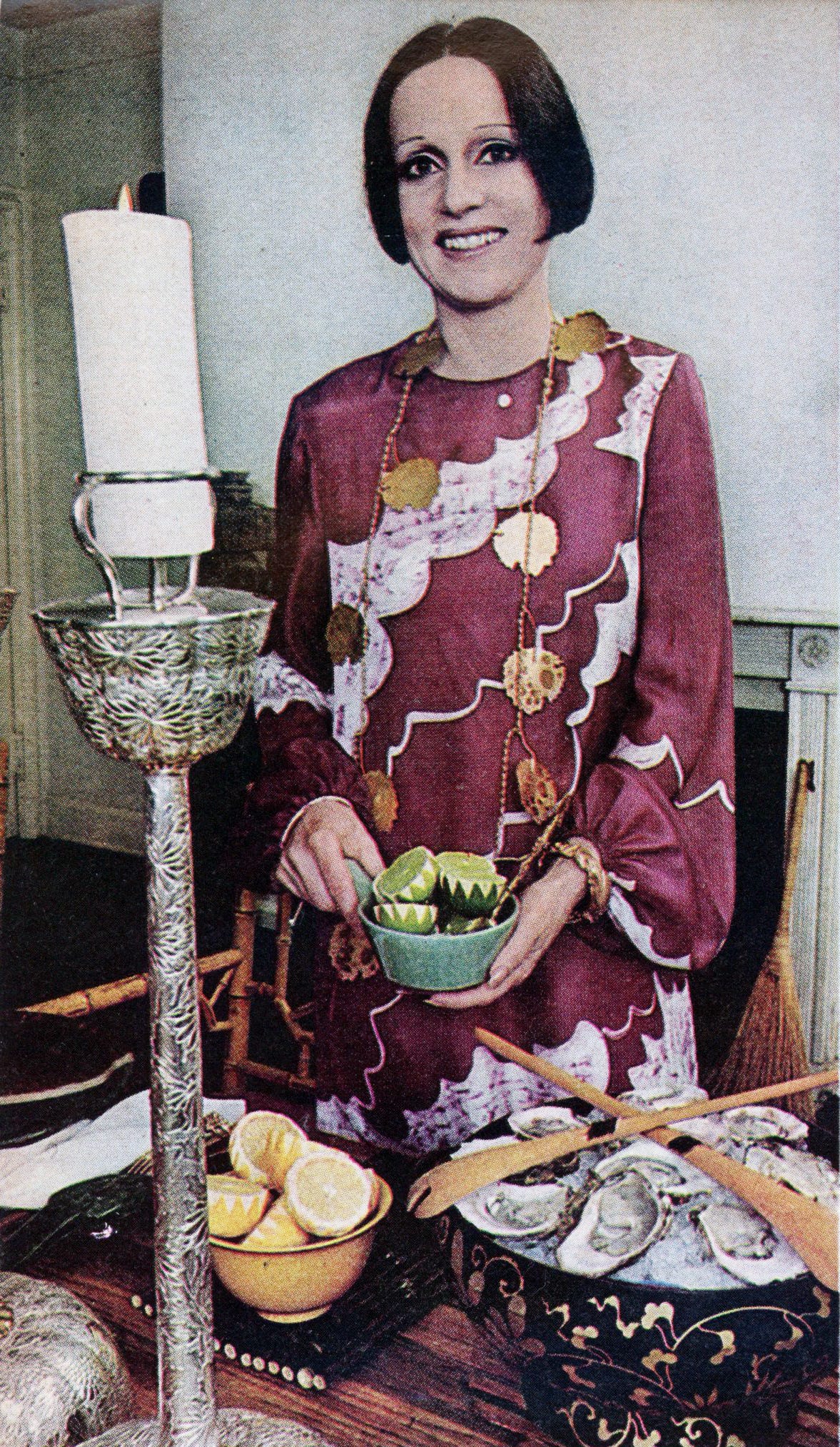The second in my series on fashion designers entertaining (you can read the first one here), drawn from a 1976 issue of House Beautiful, centres on Mary McFadden. The only one of the five designers featured still living, McFadden still stylistically cuts a formidable, striking figure—still the raven hair severely pulled back, the heavy gold jewellery, the clothes redolent of an ancient civilization.
From a piece I wrote on McFadden in 2013: “The spellbinding and intricate designs of Mary McFadden occupy their own place within fashion. Laden with historical references, McFadden found a way to blend a vast array of inspirations into designs that appear timeless. While her clothes resonated perfectly with the period she was designing in (1970s-1990s), the use of classical line and form has allowed them to maintain their wearability today. Equally intriguing as her designs is McFadden’s life—raised in Memphis and Long Island, she worked as a PR for Christian Dior New York before marrying a director of the South African diamond company, De Beers. After several years of living in South Africa and working for their edition of Vogue, she began to have her clothes made using local fabrics, which made a splash when she returned to New York and a job as special projects editor at Vogue in 1970. Henri Bendel came calling and from there she designed couture and ready-to-wear collections, and created an empire of licensing deals that included linens, jewelry and all types of apparel. With her ‘Marii’ pleated dresses, McFadden created a trademark style that made them a favorite of society ladies who were attracted to the unequivocal elegance of them—Jacqueline Onassis wore a white strapless pleated McFadden sheath to the Met Ball in 1976.”

On a personal note, Mary changed my life. Years ago, when I decided to go back to school to study fashion history yet knew no one in that world, my mother told a friend about my conundrum. By chance, this friend had met Mary at a Noble Prize event (Mary’s longtime partner was Murray Gell-Mann, who received the 1969 Nobel Prize for Physics). She gave me Mary’s number and advised me to call, suggesting that Mary might have an archive or be able to help me in some way. Consumed by nerves, I avoided calling her for weeks. Sitting in the dark in the photographer’s studio where I worked, I finally rang her and she picked up immediately. After quickly listening to my explanation, Mary invited me to a museum exhibition opening that week. As soon as I arrived and introduced myself, she turned to the curator (one of her ex-husbands) and told him to hire me. Within three days I was writing bios about models for the Costume Institute’s “Model as Muse” exhibition. I will forever be thankful to her for her generosity.
Over the years I’ve interviewed her several times and visited her current apartment—Mary now lives with floor-to-ceiling windows overlooking the East River, sunshine illuminating the ancient Roman and Etruscan gold jewellery and objects she has out on display. It is utterly fabulous and as completely her as the brownstone duplex-plus-roof garden apartment (in the East Seventies) where she lived in the 1970s, as seen in the House Beautiful profile. It took her four months to remodel that duplex, creating an austere architectural space that served as a showcase for her collection of Indian, African, Chinese, and Native American works of art. These 1972 images by Horst were taken while Mary was still special features editor at Vogue, and provide a clearer idea of the layout of the apartment and the space as a whole.
Should I repost an interview I did with Mary in 2013? Comment to let me know if you would be interested.
Text below by Carmine Porcelli and photos below by Feliciano for House Beautiful, November 1976.
Mary McFadden: A certain purity, a direct sharing of honest food with an art collection as a background
"I like to give dinners so that I can give my friends a unique experience—a vacation from the hectic work week," says Mary McFadden, the designer whose fashion designs and exotic prints have lately won her a Coty Award. Unique in itself, her New York apartment has the quality of a small, quiet museum of the art she has collected from Africa (where she once lived), Asia and the contemporary galleries of Madison Avenue. "Art is a part of my life. So, when I'm dining, it must also be part of the table." Hence, she delights her guests with charming, unexpected dinner settings where every object is something to examine and admire.
"I guess my career and home really do reflect. Whether I'm designing or entertaining, I think of the esthetics first." Her menus echo this. "I like food to be prepared and served with great delicacy. I prefer it as pure as possible, never over-cooked or over-sauced. I try to serve whatever is freshest at the moment, so my menus vary with the season." A favorite menu: fresh oysters in their shells on a bed of ice, sea bass with ginger and cold chestnut soufflé.
"Mary's table settings are the most exotic and creative anywhere, and the food is always the most imaginative—a true experience in every way," says frequent guest Justine Cushing. In the dining room, see contemporary wall hangings by Dorothea Rockburne, Rhodesian sculpture by Amani, contrasted with the natural bamboo motif of English Regency chairs.
Setting the table, there's an unlikely but magnificent melange of curiously compatible objects, many of museum caliber. An Oriental bowl holds iced oysters. Serpentine stone wine caddy is Rhodesian. From 18th-century Japan come silver repousse candlesticks and a fine black-and-gold lacquer box that's seen, on this occasion, highlighted as a centerpiece and flanked by modern, marbleized glass stemware. Plates are contemporary pottery, vermeil flatware 19th-century Russian, bamboo placemats are from the People's Republic of China, salts and peppers South African.
For pure adornment, in lieu of customary flowers, there are antique brass flowers from Japan, a sculptured Egyptian head, a Nigerian bronze of the Benin tribe, A basket holds extra napkins. Green stone serving piece is from the Ming dynasty.












Yes, I'd love to read your interview with MM.
Love this article! How fascinating she is! Yes please on your interview with her.